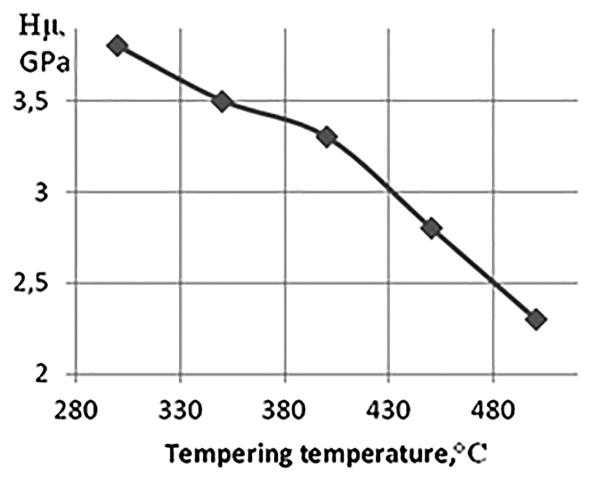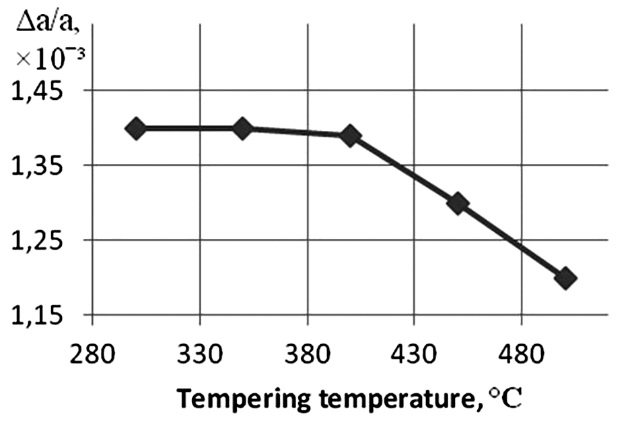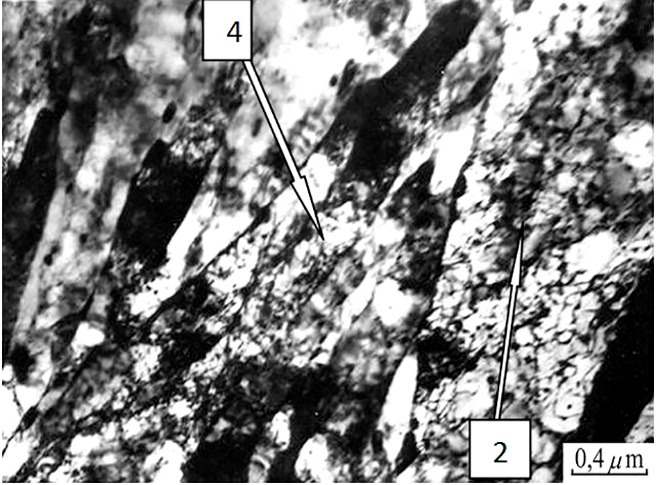ISSN
2307–3489 (Print), ІSSN 2307–6666 (Online)
Наука
та прогрес транспорту. Вісник
Дніпровського
національного університету залізничного
транспорту, 2019, № 1 (79)
МАтеріалознавство
матеріалознавство
UDC
669.14/15:621.78
I.
O. VAKULENKO1,
S. V.
PROIDAK2,
L. I.
VAKULENKO3,
N.
A. GRISCHENKO4
1Dep.
«Applied Mechanics and Materials Science», Dnipro National
University of Railway
Transport named after Academician V. Lazaryan,
Lazaryan St., 2, Dnipro, Ukraine, 49010,
tel. + 38 (056) 373 15 56,
e-mail dnuzt_texmat@ukr.net,
ORCID 0000-0002-7353-1916
2Dep.
«Applied Mechanics and Materials Science», Dnipro National
University of Railway
Transport named after Academician V. Lazaryan,
Lazaryan St., 2, Dnipro, Ukraine, 49010,
tel. + 38 (056) 373 15 56,
e-mail proydak.S@gmail.com,
ORCID 0000-0003-2439-3657
3Management
of Prydniprovsk Railway, Yavornytskyi Av., 107, Dnipro, Ukraine,
49054,
tel. +38 (095) 466 08 50, e-mail dnuzt_texmat@ukr.net,
ORCID 0000-0003-2616-740X
4Dep.
«Applied Mechanics and Materials Science», Dnipro National
University of Railway
Transport named after Academician V. Lazaryan,
Lazaryan St., 2, Dnipro, Ukraine, 49010,
tel. + 38 (056) 373 15 56,
e-mail dnuzt_texmat@ukr.net, ORCID 0000-0002-0091-1387
SOFTENING OF
HARDENED MEDIUM-CARBON
STEEL DURING HEATING
Purpose. The
work is aimed to clarify the softening mechanism during the heating
of martensite hardened carbon steel, which is of practical
importance, especially in the development of the production
technology of rolled products with different levels of hardening.
Methodology. The samples after martensite hardening were
tempered at the temperatures of 300-500˚С. The microstructure was
investigated under the electron microscope. Thin foils were made
using the Bolman and tweezer methods in chlorous-acetic solution and
Morris reagent. Phase distortions of crystalline lattice were
determined by the methods of X-ray structural analysis, using the
diffractometer. The cold-worked layer of metal after grinding was
removed by electrolytic dissolution. Tensile strength brake of the
metal was determined using the tensile diagrams of samples using the
Instron type machine. Microhardness was measured using the PMT-3
device with indentation load 0.49 N.
Findings. When heating the hardened steel to a temperature of
300˚C, the softening effect is mainly related to the rate of
reduction of the accumulated as a result of martensitic
transformation, density of the crystalline structure defects. The
total result is caused by the development of dislocations
recombination and strengthening because of the emergence of
additional number of cementite particles during the martensitic
crystals decomposition. Starting from the heating temperatures of
400˚C and above, the development of polygonization processes in the
ferrite is accompanied by the emergence of additional sub-boundaries,
which enhance the effect of metal strengthening. With increase in the
heating temperature of the hardened steel, the level of strength
properties is determined by the progressive softening from the
decrease in carbon atoms saturation degree of the solid solution,
dislocations density and increase in the size of cementite particles
over the effect of strengthening from hindering of mobile
dislocations by carbon atoms and the emergence of additional
sub-boundaries. Originality. For the tempering temperature of
300-400˚C, the absence of the phase distortion change indicates the
emergence of additional factor in strengthening the metal from the
formation of sub-boundaries and the dispersion strengthening from the
carbide particles. Practical value. The given explanation of
the mechanism of structural transformations in the process of
tempering in the average temperature range of the hardened carbon
steel can be used to optimize the technology of thermal strengthening
of rolled metal.
Keywords:
microstructure; martensite; cementite; sub-boundaries; hardening;
softening
Introduction
During the
thermal hardening using the heat of rolling heating [2,
4, 10], in the elements of products of
large sections a gradient of structures is formed, which correspond
to certain values of the strength characteristics [1, 9,
11]. The observed structural inhomogeneity
is caused by the cumulative effect of the development of phase
transformation processes with different nature of influence on the
properties. Thus, the achieved level of metal hardening is
proportional to the speed of accelerated cooling, which decreases as
the distance from the cooled rolling surface increases [5]. At the
same time, the heating temperature of the metal will increase when
approaching the central volumes [1, 4].
For the detailed
analysis, the continuous nature of the structure change across the
section of the rolled product, depending on the distance from the
cooling surface, can be conditionally divided into separate volumes
with corresponding structure and ability to work hardening [3].
Based on the above-mentioned, the changes
in the nature of behaviour when loading the specified volumes of
metal will be similar to the influence of the temperature of
individual heating when tempering the hardened steel [1]. Takin into
account the additive nature of influence of the dispersion and
morphology of the structural components on the general level of
carbon steel hardening [3],
the formation of certain gradient of structures across the rolled
product section should be considered as one of the directions of
technology optimization to achieve the required structural state and
the level of strength characteristics [1, 3,
5].
Purpose
The work is aimed to clarify the
mechanism of softening during the heating of the hardened
medium-carbon steel in the average temperature range.
Methodology
The fragments
of the railway wheel set axis made of carbon steel with the
concentration of chemical elements: 0.41% C, 0.36% Si, 0.61% Mn,
0.0022% S, 0.015% P served as a material for the research. The
plates 2 mm thick, 20 mm wide and 250 mm long were the test samples.
The samples were austenitized at temperatures higher than
 followed by forced cooling in a water tank. After hardening, the
samples were subjected to tempering at temperatures of 300-500°C
during 1 h. The heating was carried out in the SNOL electric
furnace – 1.6.2.5.1/11-IZ. The temperature was controlled by the
chromel-alumel thermocouple and DC potentiometer. The microstructure
of the samples was studied under electron microscope at accelerating
voltage of 100 kV. Thin foils for the research under electron
microscope were made using the Bolman and tweezer methods in
chlorous-acetic electrolyte and Morris reagent. During the
manufacture of the objects for X-ray studies, the cold-worked layer
of metal, after making the polished sections were removed by
dissolution in the chlorous-acetic electrolyte. The phase
distortions of crystalline lattice (
followed by forced cooling in a water tank. After hardening, the
samples were subjected to tempering at temperatures of 300-500°C
during 1 h. The heating was carried out in the SNOL electric
furnace – 1.6.2.5.1/11-IZ. The temperature was controlled by the
chromel-alumel thermocouple and DC potentiometer. The microstructure
of the samples was studied under electron microscope at accelerating
voltage of 100 kV. Thin foils for the research under electron
microscope were made using the Bolman and tweezer methods in
chlorous-acetic electrolyte and Morris reagent. During the
manufacture of the objects for X-ray studies, the cold-worked layer
of metal, after making the polished sections were removed by
dissolution in the chlorous-acetic electrolyte. The phase
distortions of crystalline lattice ( ),
where
),
where
 is the ferrite lattice parameter,
were determined by the methods of X-ray structural analysis using
the DRON-2.0 diffractometer at scintillation registration of
reflexes, in monochromatic
is the ferrite lattice parameter,
were determined by the methods of X-ray structural analysis using
the DRON-2.0 diffractometer at scintillation registration of
reflexes, in monochromatic
 radiation, at room temperature. The error in the determination
radiation, at room temperature. The error in the determination
 was up to 5%. Tensile strength brake
of the metal was evaluated under tension using the Instron type
machine, at room temperature and deformation rate of 10
was up to 5%. Tensile strength brake
of the metal was evaluated under tension using the Instron type
machine, at room temperature and deformation rate of 10 s
s .
As a characteristic of the strength of metal microvolumes, the
microhardness was used, which was measured using the PMT-3 device
with indentation load 0.49 N.
.
As a characteristic of the strength of metal microvolumes, the
microhardness was used, which was measured using the PMT-3 device
with indentation load 0.49 N.
Findings
The level of
the values of tensile strength break of the studied steel after
hardening and tempering at the temperatures of 300-500˚С
corresponded to the known experimental data for the steels with
similar chemical composition [1, 5,
7].
As the tempering temperature increases, well-defined structural
changes, detected starting from the temperatures of 200-250˚С,
correspond to the progressive metal softening [3,
9].
Indeed, as shown in the works [6, 8] for carbon steels with a
carbon content of about 0.4%, the temperature of the beginning of
martensitic transformation is about 300°C.
This
temperature should be enough to start the emission of cementite
particles from the solid solution during the formation of the
martensitic crystal itself. Thus, depending on the temperature of
the end of forced cooling, a different combination in the
development of the processes of hardening and softening in steel,
determines the final level of strength properties.
The effect of
hardening from the ordering of carbon atoms in the crystalline
lattice of the martensitic crystal [6] and quenching aging [2, 10],
when tempering at 300°C, is almost completely suppressed by the
progressive
metal softening (Fig. 1, a).
Indeed, for
steels with medium carbon content, the degree of supersaturation of
the solid solution achieved during the martensite hardening
determines the resource of maintaining the increased metal strength
after heating to certain temperatures. Based on this, it is safe to
believe that for the studied steel after hardening, the effect from
reducing the tetragonality degree of the ferrite crystalline lattice
(martensitic crystal) during low-temperature tempering can be to
some extent compensated by the increasing role of quenching aging
processes [2, 10]. However, already after
heating of hardened steel, starting from 300°C, the monotonous
nature of the decrease in strength characteristics indicates a
definite excess of softening effect over hardening (Fig. 1, a).
A qualitatively
different nature
of the
dependence on
tempering
temperature is
observed for
the value
of the
phase
distortions
(Fig. 1, b).
A comparative analysis of the absolute
values of these characteristics, depending on the structural state
of the metal, showed that as a result of tempering at 400°C, the
 reduction reaches about 40-43%, and for
reduction reaches about 40-43%, and for
 up to 20% of relatively hardened state. After tempering at 500°C,
the values of the corresponding characteristics are 58 and 30%,
respectively. Thus, the observed differences in the nature of
changes of
up to 20% of relatively hardened state. After tempering at 500°C,
the values of the corresponding characteristics are 58 and 30%,
respectively. Thus, the observed differences in the nature of
changes of
 and
and
 at
tempering up to 400°C (Fig. 1) can be associated only with
different sensitivity to sub-structural changes during tempering of
the hardened steel. It is hoped that the analysis of the
microstructure of hardened steel after tempering at 400°C made it
possible to explain the nature of change of
at
tempering up to 400°C (Fig. 1) can be associated only with
different sensitivity to sub-structural changes during tempering of
the hardened steel. It is hoped that the analysis of the
microstructure of hardened steel after tempering at 400°C made it
possible to explain the nature of change of
 .
.
a

b

Fig. 1. Influence
of tempering temperature
on micro hardness (а) and micro
distortions
(b) of the hardened steel
The
microstructure presented in Fig. 2, a
corresponds to the hardened state, and in Fig. 2, b
– to the state after tempering at
a temperature of 400°C. The
detected sections of the lath martensite with a high dislocation
density (Fig. 2, a)
indicate the development of austenite transformation according to a
shear mechanism. The laths width is generally up to 1 micron.
At
sufficiently careful study, in separate martensitic crystals,
simultaneously with thin twins (designation 1), stroked randomly
oriented cementite emissions of high dispersity (designation 2) were
found, Fig. 2, a.
Analysis of the results [2, 8] indicates that the emergence of the
observed emissions of the carbide phase is in fact caused by the
development of the decomposition processes of martensitic crystals,
which are formed at
a relatively high transformation
temperature.
a

b

Fig. 2.
Microstructure of steel after hardening
(а) and
tempering at 400˚С (b)
As compared
to
 ,
the absence of the decrease
,
the absence of the decrease
 indicates the complex change in the ratio in the development of the
softening and hardening processes of the metal. In the first
approximation, the hardening effect is provided by the simultaneous
influence of the formation of additional interfaces in the ferrite
(sub-boundaries) and dispersion hardening from the emitted carbide
particles (Fig. 2, b).
Considering the influence of cementite
particles on the hardening effect separately, it should be noted
that in addition to the carbide particles formed during steel
hardening, the influence from the emitted particles even when
tempering of the hardened steel is added. As follows from the works
[6, 8], simultaneously with the emission of the dispersed particles
during tempering, the processes of spheroidization and coalescence
for the particles that are formed during martensitic transformation
receive a certain acceleration. Thus,
the expected total hardening effect from the dispersed particles of
cementite, which are formed as a result of tempering, will in fact
be somewhat reduced. However, in fact, based on a comparative
analysis of the microstructure (Fig. 2), no evidence of the
existence of carbide particles with markedly increased sizes was
found. At a sufficiently careful study of the structure, the
particles of cementite located at the sub-boundaries (formed during
tempering) and in the internal volumes of the former martensitic
crystals (hardening precipitation) (Fig. 2, b,
designation 1) have almost identical diameters. On the basis of the
known results of the study, the permanence of particle sizes is
explained by the cyclical nature of the change in the stages of
particles growth, when they are located at the grain boundaries due
to the dissolving particles located inside of the grain. Thus,
despite the fact that at heating temperatures up to 400
indicates the complex change in the ratio in the development of the
softening and hardening processes of the metal. In the first
approximation, the hardening effect is provided by the simultaneous
influence of the formation of additional interfaces in the ferrite
(sub-boundaries) and dispersion hardening from the emitted carbide
particles (Fig. 2, b).
Considering the influence of cementite
particles on the hardening effect separately, it should be noted
that in addition to the carbide particles formed during steel
hardening, the influence from the emitted particles even when
tempering of the hardened steel is added. As follows from the works
[6, 8], simultaneously with the emission of the dispersed particles
during tempering, the processes of spheroidization and coalescence
for the particles that are formed during martensitic transformation
receive a certain acceleration. Thus,
the expected total hardening effect from the dispersed particles of
cementite, which are formed as a result of tempering, will in fact
be somewhat reduced. However, in fact, based on a comparative
analysis of the microstructure (Fig. 2), no evidence of the
existence of carbide particles with markedly increased sizes was
found. At a sufficiently careful study of the structure, the
particles of cementite located at the sub-boundaries (formed during
tempering) and in the internal volumes of the former martensitic
crystals (hardening precipitation) (Fig. 2, b,
designation 1) have almost identical diameters. On the basis of the
known results of the study, the permanence of particle sizes is
explained by the cyclical nature of the change in the stages of
particles growth, when they are located at the grain boundaries due
to the dissolving particles located inside of the grain. Thus,
despite the fact that at heating temperatures up to 400 C,
the process of carbon atoms emission from the tetragonal insertion
positions is almost completed, as evidenced by the decrease in the
blurring of reflections in microdiffraction photographs and the
broadening of x-ray interferences [2, 6]. The insufficient
acceleration of cementite coalescence is one of the reasons for a
certain decrease in the rate of steel softening. The presence of
unessential anomaly on the monotonous course of the curve
C,
the process of carbon atoms emission from the tetragonal insertion
positions is almost completed, as evidenced by the decrease in the
blurring of reflections in microdiffraction photographs and the
broadening of x-ray interferences [2, 6]. The insufficient
acceleration of cementite coalescence is one of the reasons for a
certain decrease in the rate of steel softening. The presence of
unessential anomaly on the monotonous course of the curve
 (Fig. 1, a)
confirms these positions.
(Fig. 1, a)
confirms these positions.
With a
further increase in tempering temperature, the sub-structural
changes observed at 400°C receive additional acceleration. As
follows from the microstructure analysis (Fig. 3), the heating to
500°C is already sufficient for the beginning of the formation of
the sections with almost equiaxial subgrains in the hardened steel.
(Fig. 3, a,
designation 1). At the same time, there are volumes in the metal in
which the formation of sub-boundaries is just beginning (Fig. 3, a,
designation 2).
a

b

Fig. 3.
Microstructure of steel after hardening
and tempering at 500˚С
Based on
this, the differences in the conditions for the beginning of
spheroidization and coalescence processes of cementite particles in
the metal microvolumes are one of the reasons for the formation of a
certain sub-structural heterogeneity. In microvolumes in which a
significant amount of finely dispersed carbide particles have been
preserved, the polygonization processes are significantly inhibited,
as evidenced by the increased dislocation density (Fig. 3, a,
designation 3). In contrast, in the sections with more intensive
polygonization development, the dislocations redistribution leads to
the improvement of sub-boundaries, the purification of the internal
volumes of fragmented martensitic crystals from unbound dislocations
(Fig. 3, b,
designation 4). Considering that the additional formation of
sub-boundaries and the emission of cementite particles by the nature
of their influence are related to hardening, these phenomena should
slow down the development of softening processes with increasing the
tempering temperature. From the analysis of the results, it follows
that the cumulative effect of softening during tempering of hardened
steel from the solid solution decomposition, reducing the
dislocation density and the coalescence of carbide particles exceeds
the hardening from the interaction of dislocations with carbon
atoms, the formation of additional sub-boundaries and the hardening
from cementite particles of various dispersity.
Originality and practical
value
During the research it was for
the first time established that for the tempering temperatures of
300–400°C, the absence of phase distortions change indicates the
emergence of additional factor in the metal hardening from the
formation of sub-boundaries and the dispersion hardening from
carbide particles.
The given explanation of the
mechanism of structural transformations in the process of tempering
in the average temperature range of the hardened carbon steel can be
used to optimize the technology of thermal hardening of rolled
products.
Conclusions
1. During the tempering of
hardened steel in the temperature range of 300-500˚С, the effect
of softening from the solid solution decomposition, the reduction of
dislocation density and the coalescence of carbide particles exceeds
hardening from the dislocations interaction with carbon atoms, the
formation of additional sub-boundaries and dispersion hardening from
cementite particles.
2. The
dependence of the value
of the phase distortion indicates the development of complex
structural changes during the tempering of 300–400°C in hardened
steel with the opposite nature of influence on the strength
properties.
LIST OF
REFERENCE LINKS
Бабаченко,
А. И. Надежность и
долговечность железнодорожных колес
и бандажей. – Днепропетровск
: Приднепров. гос. акад.
стр-ва и архитектуры, 2015. –
350 с.
Большаков,
В. И. Атлас структур металлов и сплавов
/ В. И. Большаков, Г. Д. Сухомлин,
Н. Э.
Погребная. – Днепропетровск : Gaudeamus,
2001. – 114 с.
Гриднев,
В. Н. Прочность и
пластичность холодно деформированной
стали / В. Н. Гриднев,
В. Г. Гаврилюк,
Ю. Я. Мешков. – Киев :
Наукова думка, 1974. – 231 с.
Кинетика
превращения аустенита в рельсовых
сталях марок М74 и 75ХГСМ при непрерывном
охлаждени / Ф. К. Ткаченко, С. О. Кузьмин,
В. Г. Ефременко, В. Г.
Казанков // Вісн. Дніпропетр.
нац. ун-ту
залізн. трансп.
ім. акад.
В. Лазаряна. – Дніпропетровськ,
2009. – Вип. 29. – С. 198–201.
Совершенствование
химического состава стали для
железнодорожных колес, обеспечивающего
повышение их стойкости к образованию
дефектов на поверхности катания / А.
И. Бабаченко,
П. Л.
Литвиненко, А. В. Кныш,
Ж. А. Дементьева, А.
Н. Хулин, Е. А. Шпак
//
Фундаментальные и прикладные проблемы
черной металлургии : сб. науч. тр. –
Днепропетровск, 2011. – Вып. 23. – С.
226–233.
Bhadesha,
H. K. D. H. Bainite in steels:
Transformations, Microstructure and Properties
/
H. K.
D. H.
Bhadesha. – Cambridge : The
University
Press, 2001. – 478
p.
Effect
of morphologies of martensite–austenite constituents on impact
toughness in inter critically reheated coarse-grained heat-affected
zone of HSLA steel / Xiang
Luo, Xiaohua Chen, Tao Wang, Shiwei Pan, Zidong Wang
// Materials Science and Engineering: A.
– 2018. – Vol.
710. – P. 192–199.
doi:
10.1016/j.msea.2017.10.079
Powder
metallurgical
nanostructured
medium
carbon
bainitic
steel:
Kinetics, structure, and in situ thermal stability studies /
I. Lonardelli, M. Bortolotti, W. van Beek [et al.] // Materials
Science and Engineering: A. – 2012. –
Vol. 555. – P. 139–147. doi:
10.1016/j.msea.2012.06.043
Structure
and properties of the steel railway wheel disc after forced cooling
/ I.
Vakulenko, N. Grischenko,
L.
Vakulenko, V.
Efremenko, S.
Proiydak, O.
Perkov // Scientific Journal of Silesian University of Technology.
Series
Transport.
– 2018. – Vol. 98. – P.
173–180. doi:
10.20858/sjsutst.2018.98.16
Vakulenko,
I. Influence of cooling rate on the strength of the ring of railway
wheel / I. Vakulenko // Materials Science. –
2016. – Vol. 51. – Iss. 6. – P.
839–842. doi:
10.1007/s11003-016-9910-8
Vakulenko,
I. Investigation of slide mechanism of tread during operation of
railway wheel / I. Vakulenko,
S. Proidak,
O. Perkov // Scientific Journal of
Silesian University of Technology. Series
Transport.
– 2016. – Vol. 90. – P.
185–193. doi:
10.20858/sjsutst.2016.90.16
І.
О. ВАКУЛЕНКО ,
С. В. ПРОЙДАК
,
С. В. ПРОЙДАК ,
Л. І. ВАКУЛЕНКO
,
Л. І. ВАКУЛЕНКO ,
М. А. ГРИЩЕНКО
,
М. А. ГРИЩЕНКО
1Каф.
«Прикладна механіка і матеріалознавство»,
Дніпровський національний університет
залізничного
транспорту імені академіка
В. Лазаряна, вул. Лазаряна, 2, Дніпро,
Україна, 49010, тел. +38 (056) 373 15 56,
ел. пошта
dnuzt_texmat@ukr.net,
ORCID 0000-0002-7353-1916
2Каф. «Прикладна
механіка і матеріалознавство»,
Дніпровський національний університет
залізничного
транспорту імені академіка
В. Лазаряна, вул. Лазаряна, 2, Дніпро,
Україна, 49010, тел. +38 (056) 373 15 56,
ел. пошта
proydak.S@gmail.com, ORCID 0000-0003-2439-3657
3Управління
Придніпровської залізниці, просп.
Дмитра Яворницького, 107, Дніпро, Україна,
49054,
тел. + 38 (095) 466 08 50, ел. пошта dnuzt_texmat@ukr.net
,
ORCID 0000-0003-2616-740Х
4Каф. «Прикладна
механіка і матеріалознавство»,
Дніпровський національний університет
залізничного
транспорту імені академіка
В. Лазаряна, вул. Лазаряна, 2, Дніпро,
Україна, 49010, тел. +38 (056) 373 15 56,
ел. пошта dnuzt_texmat@ukr.net
,
ORCID 0000-0002-0091-1387
ЗНЕМІЦНЕННЯ
ПІД ЧАС НАГРІВАННЯ ЗАГАРТОВАНОЇ
СЕРЕДНЬОВУГЛЕЦЕВОЇ СТАЛІ
Мета.
У роботі необхідно провести уточнення
механізму пом’якшення при нагріві
загартованої на мартенсит вуглецевої
сталі, що має важливе практичне значення,
особливо при розробці технології
виробництва прокату з різним рівнем
зміцнення. Методика.
Зразки після гартування на мартенсит
відпускали при температурах 300–500˚С.
Мікроструктуру досліджували під
електронним мікроскопом. Фольги
виготовляли методами Больмана і пінцету,
в хлорно-оцтовому розчині й реактиві
Морріса. Викривлення другого роду
кристалічної решітки визначали за
методиками рентгенівського структурного
аналізу з використанням дифрактометра.
Наклепаний шар металу після шліфування
видаляли електролітичним розчиненням.
Тимчасовий опір руйнуванню визначали
з діаграм розтягання зразків на машині
типу «Інстрон». Мікротвердість вимірювали
з використанням приладу ПМТ-3, з
навантаженням на индентор 0,49 Н.
Результати.
При нагріванні до температури 300 ˚С
загартованої сталі ефект пом’якшення
пов’язаний з темпом зниження накопиченої
в результаті мартенситного перетворення
щільності дефектів кристалічної будови.
Сумарний результат обумовлений розвитком
рекомбінації дислокацій та пом’якшенням
від появи додаткових частинок цементиту
при розпаді мартенситних кристалів.
Починаючи від температур нагріву 400 ˚С
і вище, розвиток процесів полігонізації
у фериті супроводжується виникненням
додаткових субмеж, які підсилюють ефект
зміцнення металу. З підвищенням
температури нагріву загартованої сталі
рівень міцності властивостей визначається
прогресуючим пом’якшенням від зниження
ступеня пересичення атомами вуглецю
твердого розчину, густини дислокацій
і збільшення розміру частинок цементиту
над ефектом зміцнення від гальмування
рухомих дислокацій атомами вуглецю та
виникнення додаткових субмеж. Наукова
новизна. Для температур
відпуску 300–400 ˚С
відсутність зміни спотворень другого
роду свідчить про появу додаткового
фактора в зміцненні металу від формування
субмеж і дисперсійного зміцнення від
карбідних частинок. Практична
значимість. Наведене
пояснення механізму структурних
перетворень в процесі відпуску в
середньому інтервалі температур
загартованої вуглецевої сталі може
бути використано для оптимізації
технології термічного зміцнення
прокату.
Ключові
слова: мікроструктура; мартенсит;
цементит; субмежі; гартування; пом’якшення
И. А.
ВАКУЛЕНКО ,
С. В. ПРОЙДАК
,
С. В. ПРОЙДАК ,
Л. И. ВАКУЛЕНКО
,
Л. И. ВАКУЛЕНКО ,
Н. А. ГРИЩЕНКО
,
Н. А. ГРИЩЕНКО
1Каф.
«Прикладная механика и материаловедение»,
Днипровский национальный университет
железнодорожного
транспорта имени
академика В. Лазаряна, ул. Лазаряна, 2,
Днипро, Украина, 49010, тел. +38 (056) 373 15 56,
эл. почта dnuzt_texmat@ukr.net, ORCID
0000-0002-7353-1916
2Каф.
«Прикладная механика и материаловедение»,
Днипровский национальный университет
железнодорожного
транспорта имени
академика В. Лазаряна, ул. Лазаряна, 2,
Днипро, Украина, 49010, тел. +38 (056) 373 15 56,
эл. почта proydak.S@gmail.com, ORCID
0000-0003-2439-3657
3Управление
Приднепровской железной дороги, просп.
Дмитрия Яворницкого, 107, Днипро, Украина,
49054,
тел. + 38 (095) 466 08 50, эл. почта
dnuzt_texmat@ukr.net , ORCID 0000-0003-2616-740Х
4Каф.
«Прикладная механика и материаловедение»,
Днипровский национальный университет
железнодорожного
транспорта имени
академика В. Лазаряна, ул. Лазаряна, 2,
Днипро, Украина, 49010, тел. +38 (056) 373 15 56,
эл. почта dnuzt_texmat@ukr.net, ORCID 0000-0002-0091-1387
РАЗУПРОЧНЕНИЕ
ПРИ НАГРЕВЕ ЗАКАЛЕННОЙ
СРЕДНЕУГЛЕРОДИСТОЙ
СТАЛИ
Цель.
В работе необходимо провести уточнение
механизма разупрочнения при нагреве
закаленной на мартенсит
углеродистой стали, что
имеет важное практическое значение,
особенно при разработке технологии
производства проката с
разным уровнем упрочнения.
Методика.
Образцы после закалки на мартенсит
отпускали при температурах 300–500˚С.
Микроструктуру исследовали под
электронным микроскопом. Фольги
изготавливали методами Больмана и
пинцета, в хлорно-уксусном растворе
и реактиве Морриса.
Искажения второго рода кристаллической
решетки определяли по методикам
рентгеновского структурного анализа,
с использованием дифрактометра.
Наклепанный слой металла после шлифования
удаляли электролитическим растворением.
Временное сопротивление разрушению
определяли из диаграмм растяжения
образцов при испытаниях на машине типа
«Инстрон». Микротвердость измеряли с
использованием прибора ПМТ-3,
с нагрузкой на индентор 0,49 Н. Результаты.
При нагреве до 300˚С
закаленной стали эффект разупрочнения
связан с темпом снижения накопленной
в результате мартенситного превращения
плотности дефектов кристаллического
строения. Суммарный результат обусловлен
развитием рекомбинации дислокаций и
упрочнением от появления дополнительных
частиц цементита при распаде мартенситных
кристаллов. Начиная от температур 400˚С
и выше, развитие процессов полигонизации
в феррите сопровождается возникновением
дополнительных субграниц, которые
усиливают эффект упрочнения металла.
С ростом температуры нагрева закаленной
стали уровень прочностных свойств
определяется прогрессирующим
разупрочнением от снижения степени
пресыщения атомами углерода твердого
раствора, плотности дислокаций и
увеличения размера частиц цементита
над эффектом упрочнения от торможения
подвижных дислокаций атомами углерода
и возникновения дополнительных
субграниц. Научная
новизна. Для температур
отпуска 300–400 ˚С
отсутствие изменения величины
искажений второго рода свидетельствует
о появлении дополнительного фактора
в упрочнении металла от формирования
субграниц и дисперсионного упрочнения
от карбидных частиц.
Практическая значимость. Приведенное
объяснение механизма структурных
превращений в процессе отпуска в среднем
интервале температур закаленной
углеродистой стали может быть использовано
для оптимизации технологии термического
упрочнения проката.
Ключевые
слова: микроструктура;
мартенсит; цементит; субграницы; закалка;
разупрочнение
REFERENCES
Babachenko,
A. I. (2015). Nadezhnost i
dolgovechnost zheleznodorozhnykh koles i bandazhey.
Dnepropetrovsk: Pridneprovskaya
gosudarstvennaya akademiya stroitelstva i arkhitektury. (in
Russian)
Bolshakov,
V. I., Sukhomlin, G. D., & Pogrebnaya, N. E. (2001).
Atlas struktur metallov i splavov.
Dnepropetrovsk: Gaudeamus. (in Russian)
Gridnev,V.
N., Gavrilyuk, V. G., & Meshkov, Y. Y. (1974). Prochnost
i plastichnost kholodno deformirovannoy stali.
Kiev: Naukova dumka. (in Russian)
Tkachenko,
F. K., Kuzmin,
S. O.,
Yefremenko, V. H. & Kazankov,
V. H. (2009). The
kinetics of austenite transformation in the rail steel grades m74
and 75 хгсм during continuous cooling.
Bulletin of Dnipropetrovsk
National University of Railway Transport, 29,
198-201. (in Russian)
Babachenko,
A. I., Litvinenko, P. L., Knysh, A. V., Dementeva, Zh. A., Khulin,
A. N., & Shpak, Y. A. (2011). Improving
chemical composition of steel railway wheels, ensure their enhanced
resistance to surface defects skating.
Fundamentalnye i prikladnye
problemy chernoy metallurgii, 23,
226-233. (in Russian)
Bhadesha,
H. K.
D. H.
(2001). Bainite
in steels: Transformations,
Microstructure and Properties. Cambridge:
The University
Press.
(in English)
Luo,
Xiang, Chen, Xiaohua, Wang, Tao, Pan, Shiwei & Wang, Zidong
(2018). Effect
of morphologies of martensite–austenite constituents on impact
toughness in inter critically reheated coarse-grained heat-affected
zone of HSLA steel. Materials
Science and Engineering: A, 710, 192–199.
doi:
10.1016/j.msea.2017.10.079 (in
English)
Lonardelli,
I., Bortolotti, M., van Beek, W., Girardini, L., Zadra, M., &
Bhadeshia, H. K. D. H. (2012). Powder metallurgical nanostructured
medium carbon bainitic steel: Kinetics, structure, and in situ
thermal stability studies. Materials
Science and Engineering: A, 555,
139-147. doi: 10.1016/j.msea.2012.06.043
(in English)
Vakulenko,
I., Grischenko, N., Vakulenko, L., Efremenko, V., Proiydak, S., &
Perkov, O. (2018). Structure and properties of the steel railway
wheel disc after forced cooling. Scientific
Journal of Silesian University of Technology. Series Transport, 98,
173-180. doi: 10.20858/sjsutst.2018.98.16
(in English)
Vakulenko,
I. O. (2016). Influence of Cooling Rate on the Strength of the Rims
of Railway Wheel. Materials Science,
51(6), 839-842.
doi: 10.1007/s11003-016-9910-8 (in
English)
Vakulenko,
I., Proidak, S., & Perkov, O. (2016). Investigation of slide
mechanism of tread during operation of railway wheel. Scientific
Journal of Silesian University of Technology. Series Transport, 90,
185-193.
doi: 10.20858/sjsutst.2016.90.16 (in
English)
Received:
Sep. 03, 2018
Accepted:
Jan. 03, 2019
followed by forced cooling in a water tank. After hardening, the
samples were subjected to tempering at temperatures of 300-500°C
during 1 h. The heating was carried out in the SNOL electric
furnace – 1.6.2.5.1/11-IZ. The temperature was controlled by the
chromel-alumel thermocouple and DC potentiometer. The microstructure
of the samples was studied under electron microscope at accelerating
voltage of 100 kV. Thin foils for the research under electron
microscope were made using the Bolman and tweezer methods in
chlorous-acetic electrolyte and Morris reagent. During the
manufacture of the objects for X-ray studies, the cold-worked layer
of metal, after making the polished sections were removed by
dissolution in the chlorous-acetic electrolyte. The phase
distortions of crystalline lattice (
),
where
is the ferrite lattice parameter,
were determined by the methods of X-ray structural analysis using
the DRON-2.0 diffractometer at scintillation registration of
reflexes, in monochromatic
radiation, at room temperature. The error in the determination
was up to 5%. Tensile strength brake
of the metal was evaluated under tension using the Instron type
machine, at room temperature and deformation rate of 10
s
.
As a characteristic of the strength of metal microvolumes, the
microhardness was used, which was measured using the PMT-3 device
with indentation load 0.49 N.
reduction reaches about 40-43%, and for
up to 20% of relatively hardened state. After tempering at 500°C,
the values of the corresponding characteristics are 58 and 30%,
respectively. Thus, the observed differences in the nature of
changes of
and
at
tempering up to 400°C (Fig. 1) can be associated only with
different sensitivity to sub-structural changes during tempering of
the hardened steel. It is hoped that the analysis of the
microstructure of hardened steel after tempering at 400°C made it
possible to explain the nature of change of
.
,
the absence of the decrease
indicates the complex change in the ratio in the development of the
softening and hardening processes of the metal. In the first
approximation, the hardening effect is provided by the simultaneous
influence of the formation of additional interfaces in the ferrite
(sub-boundaries) and dispersion hardening from the emitted carbide
particles (Fig. 2, b).
Considering the influence of cementite
particles on the hardening effect separately, it should be noted
that in addition to the carbide particles formed during steel
hardening, the influence from the emitted particles even when
tempering of the hardened steel is added. As follows from the works
[6, 8], simultaneously with the emission of the dispersed particles
during tempering, the processes of spheroidization and coalescence
for the particles that are formed during martensitic transformation
receive a certain acceleration. Thus,
the expected total hardening effect from the dispersed particles of
cementite, which are formed as a result of tempering, will in fact
be somewhat reduced. However, in fact, based on a comparative
analysis of the microstructure (Fig. 2), no evidence of the
existence of carbide particles with markedly increased sizes was
found. At a sufficiently careful study of the structure, the
particles of cementite located at the sub-boundaries (formed during
tempering) and in the internal volumes of the former martensitic
crystals (hardening precipitation) (Fig. 2, b,
designation 1) have almost identical diameters. On the basis of the
known results of the study, the permanence of particle sizes is
explained by the cyclical nature of the change in the stages of
particles growth, when they are located at the grain boundaries due
to the dissolving particles located inside of the grain. Thus,
despite the fact that at heating temperatures up to 400
C,
the process of carbon atoms emission from the tetragonal insertion
positions is almost completed, as evidenced by the decrease in the
blurring of reflections in microdiffraction photographs and the
broadening of x-ray interferences [2, 6]. The insufficient
acceleration of cementite coalescence is one of the reasons for a
certain decrease in the rate of steel softening. The presence of
unessential anomaly on the monotonous course of the curve
(Fig. 1, a)
confirms these positions.